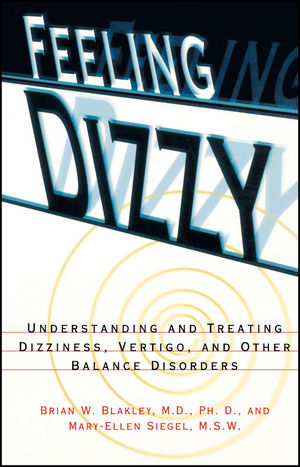Feeling Dizzy: Understanding and Treating Vertigo, Dizziness, and Other Balance DisordersISBN: 978-0-02-861680-3
Paperback
256 pages
July 1997
 This is a Print-on-Demand title. It will be printed specifically to fill your order. Please allow an additional 10-15 days delivery time. The book is not returnable.
|
||||||
Acknowledgments.
PART I: Dizziness: What Does it Mean?
Introduction.
1. The Balancing Act.
2. Feeling Off-Balance.
3. Finding the Cause of Dizziness and Vertigo.
PART II: The Causes of Dizziness.
4. Peripheral Vestibular Disorders.
Benign Paroxysmal Positional Vertigo.
Vestibular Neuronitis.
Labyrinthitis and Other Ear Infections.
Perilymph Fistula.
Cholesteatoma.
Otosclerosis.
Trauma to the Ear.
Meniere's Disease.
Recurrent Vestibulopathy.
Motion Sickness.
Height Dizziness.
5. Central and Vascular Vestibular Disorders.
Acoustic Neuroma.
Other Brain Tumors.
Cerebral Atrophy.
Disorders of the Blood Supply.
Transient Ischemic Attacks.
Stroke.
Migraine.
Epilepsy.
Multiple Sclerosis.
Other Central Vestibular Disorders.
6. Systemic Disorders.
Cardiovascular Diseases.
Bacterial and Viral Diseases.
Connective Tissue and Arthritic Problems.
Blood Disorders.
Diabetes.
Chronic Kidney Disease.
Thyroid Disorders.
Allergies.
Temporomandibular Joint Disorders (TMJ).
Medications and Other Substances.
7. Dizziness and Anxiety.
Anxiety.
Phobias.
Depression.
Somatization.
Psychotherapy and Other Treatments.
PART III: Treatment for Dizziness.
8. Medical, Dietetic, and Surgical Treatments.
Medication.
Diet.
Surgery.
9. Therapy and Rehabilitation.
Team Approach to Rehabilitation.
Physical Therapy Exercises You Can Do at Home.
Relaxation Techniques.
Hypnosis.
Biofeedback.
Psychotherapy.
Helping Yourself.
Future Hope for Chronic Dizziness.
Appendix A. Helpful Sources.
Appendix B. Suggested Reading.
Glossary.
Index.
PART I: Dizziness: What Does it Mean?
Introduction.
1. The Balancing Act.
2. Feeling Off-Balance.
3. Finding the Cause of Dizziness and Vertigo.
PART II: The Causes of Dizziness.
4. Peripheral Vestibular Disorders.
Benign Paroxysmal Positional Vertigo.
Vestibular Neuronitis.
Labyrinthitis and Other Ear Infections.
Perilymph Fistula.
Cholesteatoma.
Otosclerosis.
Trauma to the Ear.
Meniere's Disease.
Recurrent Vestibulopathy.
Motion Sickness.
Height Dizziness.
5. Central and Vascular Vestibular Disorders.
Acoustic Neuroma.
Other Brain Tumors.
Cerebral Atrophy.
Disorders of the Blood Supply.
Transient Ischemic Attacks.
Stroke.
Migraine.
Epilepsy.
Multiple Sclerosis.
Other Central Vestibular Disorders.
6. Systemic Disorders.
Cardiovascular Diseases.
Bacterial and Viral Diseases.
Connective Tissue and Arthritic Problems.
Blood Disorders.
Diabetes.
Chronic Kidney Disease.
Thyroid Disorders.
Allergies.
Temporomandibular Joint Disorders (TMJ).
Medications and Other Substances.
7. Dizziness and Anxiety.
Anxiety.
Phobias.
Depression.
Somatization.
Psychotherapy and Other Treatments.
PART III: Treatment for Dizziness.
8. Medical, Dietetic, and Surgical Treatments.
Medication.
Diet.
Surgery.
9. Therapy and Rehabilitation.
Team Approach to Rehabilitation.
Physical Therapy Exercises You Can Do at Home.
Relaxation Techniques.
Hypnosis.
Biofeedback.
Psychotherapy.
Helping Yourself.
Future Hope for Chronic Dizziness.
Appendix A. Helpful Sources.
Appendix B. Suggested Reading.
Glossary.
Index.



